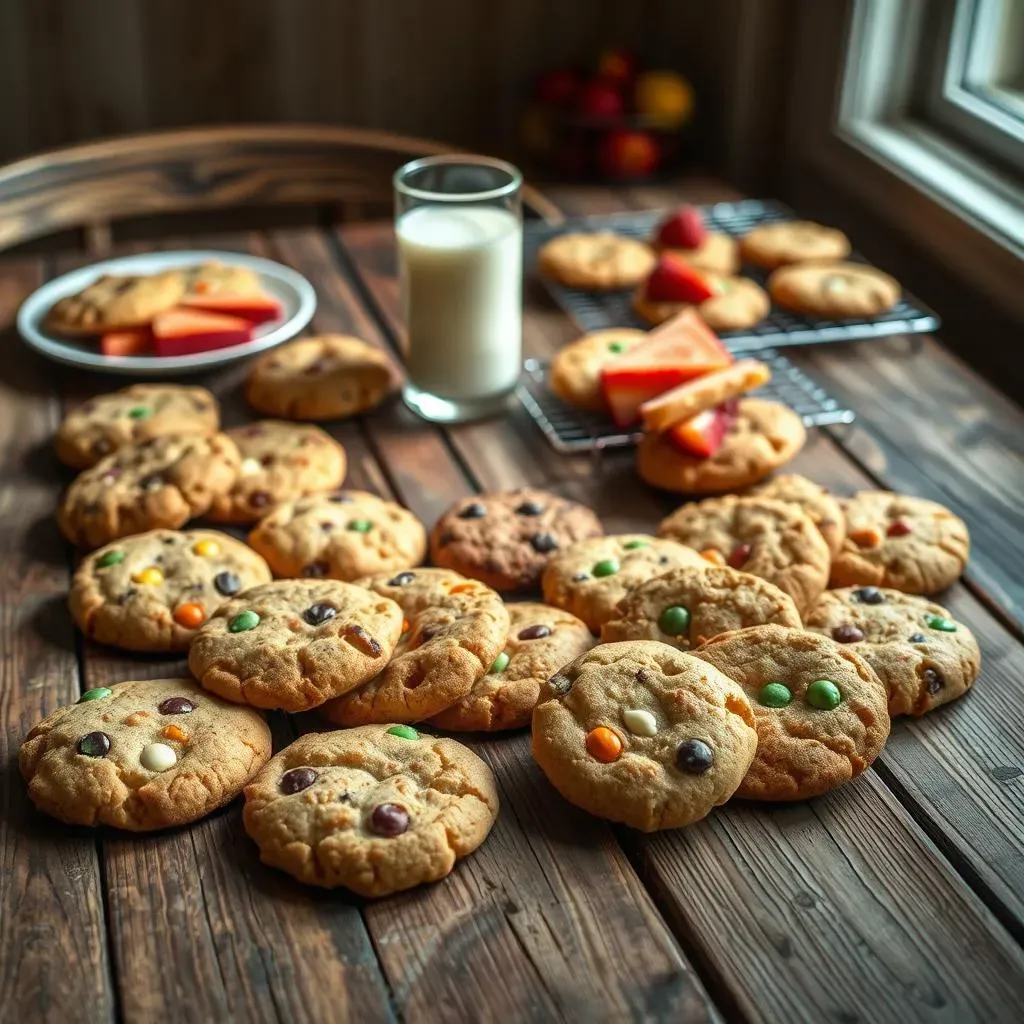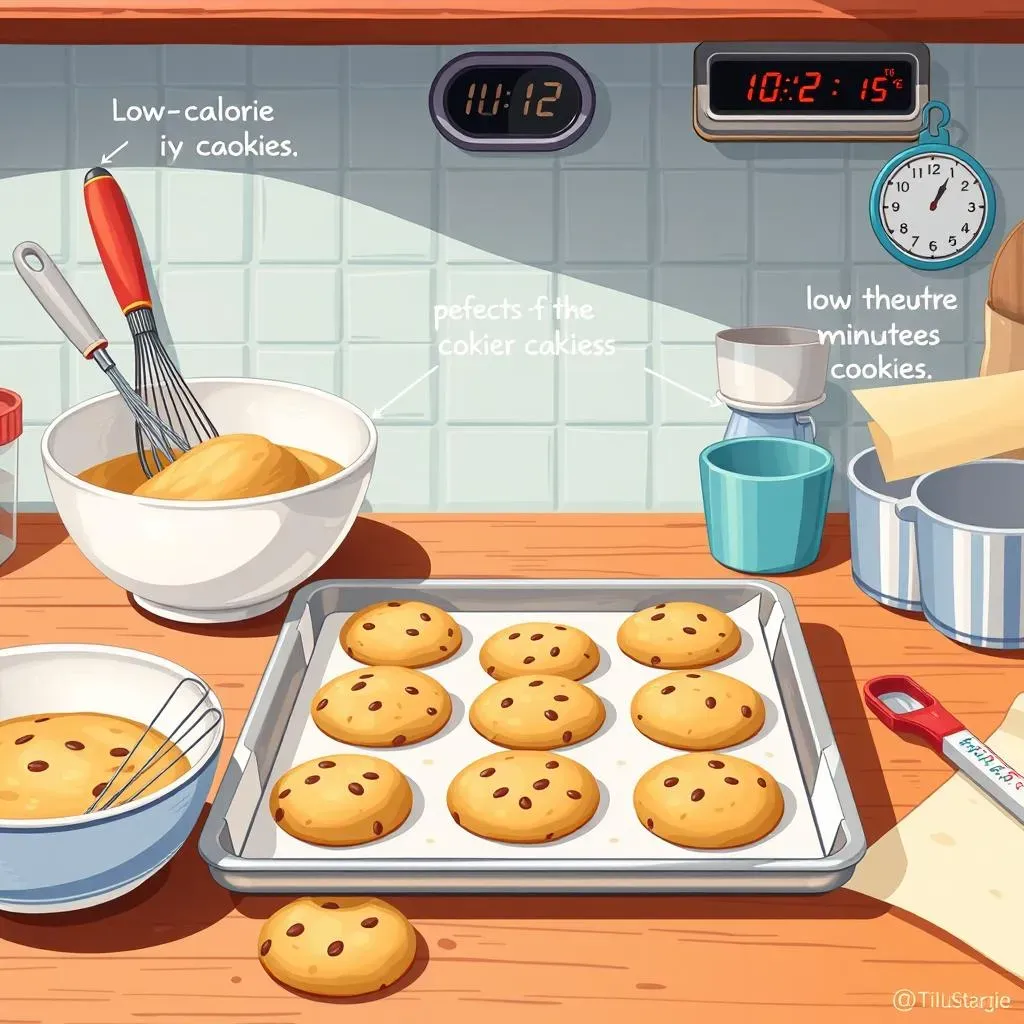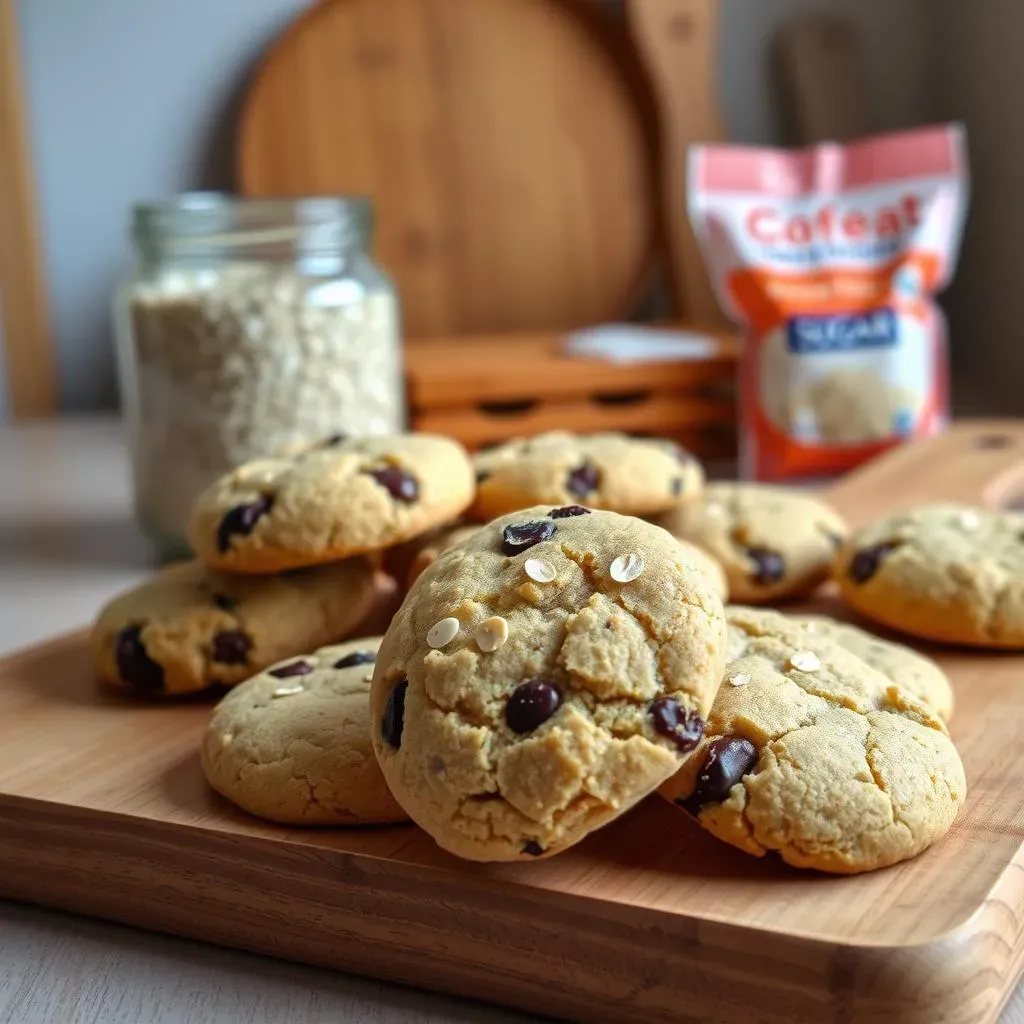Table of Contents
Who says you can't enjoy a sweet treat while trying to lose weight? I've always had a sweet tooth, and the idea of giving up cookies was just depressing. That's why I went on a mission to create low calorie cookies for weight loss that actually taste good. Forget those cardboard-like diet snacks; we're talking soft, chewy, and satisfying cookies that won't derail your goals. In this article, I'll show you exactly how to make these amazing cookies, from the basic ingredients and steps to some fun variations. We'll cover all the tips and tricks I've learned along the way, so you can bake perfect low calorie cookies every time. Plus, I'll share the best ways to store them (if they last that long!) and give you the full nutritional breakdown. Get ready to indulge without the guilt. Let's get baking and make weight loss a little sweeter!
Baking Low Calorie Cookies: Ingredients and Simple Steps

Baking Low Calorie Cookies: Ingredients and Simple Steps
The Core Ingredients
Okay, so you want cookies, but you also want to fit into your jeans, I get it. The secret to these low calorie wonders? Swapping out the usual suspects. Instead of butter, we're using unsweetened applesauce. It keeps things moist without all the fat. For flour, I like to use white whole wheat flour; it's got more fiber than regular white flour, which helps you feel full. And instead of loads of sugar, we're using a sugar substitute—I'm a big fan of erythritol, but you can use whatever you prefer. And let's not forget the chocolate—I go with sugar-free chocolate chips to keep the calorie count down. It's like a magic trick, but with baking.
Here is the basic list of ingredients we will need: White whole wheat flour, unsweetened applesauce, sugar substitute (like erythritol), sugar-free chocolate chips, baking powder, baking soda, vanilla extract, and a pinch of salt. You can use other sweeteners if you like, or even add some cinnamon or nutmeg for extra flavor. The key is to keep the ratios right so the cookies bake properly. Don't worry, I've done all the testing for you, so you can just follow along and get those perfect cookies.
Simple Steps to Cookie Heaven
Now that you've got your ingredients, let's get baking! First, you'll want to preheat your oven to 350°F (175°C). While the oven is heating, grab a big bowl and mix together your dry ingredients: the flour, baking powder, baking soda, and salt. In another bowl, mix the applesauce, sugar substitute, and vanilla extract. Then, pour the wet ingredients into the dry ingredients and mix until everything is just combined. Be careful not to overmix, or you'll end up with tough cookies.
Finally, stir in your sugar-free chocolate chips. Now, drop spoonfuls of dough onto a baking sheet lined with parchment paper. I like to use a cookie scoop to make sure they are all the same size. Bake for about 10-12 minutes, or until the edges are golden brown. Let them cool on the baking sheet for a few minutes before transferring them to a wire rack to cool completely. And that's it! You've got delicious, low calorie cookies ready to be devoured. Trust me, the hardest part is waiting for them to cool down.
Ingredient | Amount | Purpose |
|---|---|---|
White Whole Wheat Flour | 1 1/2 cups | Provides structure and fiber |
Unsweetened Applesauce | 1/2 cup | Replaces butter, adds moisture |
Sugar Substitute | 1/2 cup | Sweetens without the calories |
Sugar-Free Chocolate Chips | 1/2 cup | Adds chocolate flavor |
Baking Powder | 1 tsp | Helps cookies rise |
Baking Soda | 1/2 tsp | Helps with texture |
Vanilla Extract | 1 tsp | Adds flavor |
Salt | 1/4 tsp | Enhances flavors |
Tips and Tricks for Perfect Low Calorie Cookies Every Time

Tips and Tricks for Perfect Low Calorie Cookies Every Time
Mastering the Dough
Okay, so you've got the basic recipe down, but getting that perfect cookie is all about the details. First off, don't overmix the dough. Seriously, this is crucial. Overmixing develops the gluten in the flour, which can lead to tough, chewy cookies, and not in a good way. Mix until the ingredients are just combined, and then stop! Think of it like gently folding laundry, not aggressively wrestling with it. Also, chilling the dough for about 30 minutes before baking can make a big difference. It helps the flavors meld and prevents the cookies from spreading too much in the oven. I know it's hard to wait, but trust me, it's worth it.
Another tip? Don't be shy with the vanilla extract. It adds a ton of flavor, and we all know flavor is king, especially when we're cutting back on calories. And if you're feeling adventurous, a dash of cinnamon or nutmeg can take these cookies to the next level. Just remember, a little goes a long way. Finally, when you're scooping the dough onto the baking sheet, try to make sure they're all the same size. This helps them bake evenly, so you don’t end up with some burnt and some still raw. Consistency is key, my friend.
Baking to Perfection
Now, let's talk baking. Oven temperatures can vary, so it's always a good idea to keep an eye on your cookies. The recommended time is 10-12 minutes, but you might need a little more or less depending on your oven. Look for the edges to be golden brown, and the centers to be just set. They might still look a little soft when you take them out, but they'll firm up as they cool. Resist the urge to overbake them; you want them to be soft and chewy, not hard and crunchy. And speaking of cooling, let them sit on the baking sheet for a few minutes before transferring them to a wire rack. This prevents them from breaking apart when they're still warm and delicate.
One more thing: parchment paper is your best friend. It prevents the cookies from sticking to the baking sheet, and it makes cleanup a breeze. If you don't have parchment paper, you can use a silicone baking mat, but I find parchment paper works best. It’s like a little safety net for your cookies. If you're having trouble with your cookies spreading too much, try adding a tablespoon of flour to the dough. It can help to absorb some of the excess moisture. Remember, baking is a science, but it's also an art. Don't be afraid to experiment and find what works best for you.
Tip | Why It Works |
|---|---|
Don't Overmix | Prevents tough cookies |
Chill the Dough | Helps flavors meld and prevents spreading |
Use Parchment Paper | Prevents sticking, easy cleanup |
Watch the Oven | Prevents overbaking |
Cool on Baking Sheet | Prevents breaking |
Troubleshooting Common Issues
Sometimes, despite our best efforts, things can go wrong. If your cookies are too flat, it could be because the dough was too warm, or you might have used too much liquid. Try chilling the dough longer next time, or adding a touch more flour. If your cookies are too dry, it could be that you overbaked them. Keep a closer eye on them next time, and take them out of the oven a little sooner. Another common issue is uneven baking, which usually happens when your oven isn't heating evenly. If this is the case, try rotating the baking sheet halfway through baking.
And if you find that your sugar substitute isn't working quite right, try a different type. Some sweeteners can react differently in baking, so it might take some experimenting to find the right one for you. It’s like trying on different outfits until you find the perfect fit. Don't get discouraged if your first batch isn't perfect. Baking is a learning process, and every mistake is a chance to learn and improve. And hey, even if they're not the prettiest cookies, they'll probably still taste great. So, keep practicing, keep experimenting, and keep enjoying the sweet journey of low-calorie baking.
Customizing Your Low Calorie Cookies: Variations and Swaps

Customizing Your Low Calorie Cookies: Variations and Swaps
Sweetener Swaps: Finding Your Perfect Match
Alright, let's talk sweeteners! We've already touched on erythritol, but the world of sugar substitutes is vast and varied. If you're not a fan of erythritol, you could try stevia, monk fruit, or even a blend of different sweeteners. Each one has its own unique taste and sweetness level, so it might take a bit of experimenting to find your favorite. Just be aware that some sweeteners can have a slightly different texture or aftertaste, so start with small amounts and adjust to your preference. It's like finding the right pair of shoes – you need to try a few before you find the perfect fit. And remember, the goal is to create a cookie that you actually enjoy, not just something that's low in calories.
Another thing to keep in mind is that some sweeteners are more heat-stable than others. This means they hold up better during baking. Erythritol, for example, is pretty heat-stable, while some other sweeteners might lose some of their sweetness when heated. So, do a little research on your chosen sweetener before you start baking. And don't be afraid to mix and match! You could try using half erythritol and half stevia, or any other combination that tickles your fancy. The key is to find that perfect balance of sweetness that makes your taste buds happy without adding extra calories. It's like creating your own personal symphony of flavor.
Flour Power: Exploring Different Bases
Now, let's talk about flour. We've been using white whole wheat flour, which is a great option for adding some fiber, but there are other flours you can experiment with. If you're gluten-free, you could try almond flour or coconut flour. Keep in mind that these flours have different properties, so you might need to adjust the other ingredients to get the right consistency. Almond flour tends to be a bit more moist, while coconut flour is very absorbent, so you might need to use more liquid.
You can also try using oat flour, which adds a lovely nutty flavor, or a blend of different flours. It's like having a box of crayons – each one adds a different shade to your creation. When experimenting with different flours, it's always a good idea to start with a small batch to make sure you like the results. And don't be afraid to get creative! You could even add some flaxseed meal or chia seeds for extra fiber and nutrients. It’s like giving your cookies a little nutritional boost. The possibilities are endless, so have some fun and see what you can come up with. Who knows, you might discover your new favorite cookie recipe.
Swap | Why It Works |
|---|---|
Stevia for Erythritol | Different taste profile |
Almond Flour for Wheat Flour | Gluten-free option |
Oat Flour for Wheat Flour | Adds nutty flavor |
Flaxseed Meal | Adds fiber and nutrients |
Add-Ins and Mix-Ins: Elevating Your Cookies
Okay, so you've nailed the base of your cookie, now let's have some fun with add-ins! This is where you can really let your creativity shine. If you're a nut lover, try adding some chopped walnuts, pecans, or almonds. Just make sure they're unsalted to keep the calorie count down. Or, you could add some seeds like sunflower seeds or pumpkin seeds for a little extra crunch. And if you're a fan of dried fruit, try adding some raisins, cranberries, or chopped apricots. Just be mindful of the sugar content, as some dried fruits can be quite high in sugar. It’s like adding little treasures to your cookies.
For a chocolate lover, you can experiment with different types of sugar-free chocolate chips. You could use dark chocolate, milk chocolate, or even white chocolate chips. Or, you could add some cocoa powder to the dough for an extra chocolatey flavor. And if you're feeling adventurous, you could add some spices like cinnamon, nutmeg, or ginger. It’s like giving your cookies a little extra warmth and flavor. The key is to have fun and experiment with different combinations until you find your perfect mix. Don't be afraid to get a little messy and try something new. After all, baking should be a fun and creative process. It's like being an artist, but with delicious results.
Storing, Freezing, and Nutritional Info of Low Calorie Cookies for Weight Loss

Storing, Freezing, and Nutritional Info of Low Calorie Cookies for Weight Loss
Keeping Your Cookies Fresh
Okay, so you’ve baked a batch of these amazing low calorie cookies, and now you’re wondering how to keep them fresh. I get it, nobody wants a stale cookie. The best way to store these cookies is in an airtight container at room temperature. They’ll stay nice and soft for about 5 days. If you live in a very humid environment, you might want to add a piece of parchment paper or a paper towel to the bottom of the container to absorb any extra moisture. This will help prevent them from getting soggy. I usually use a glass container with a tight-fitting lid, but any airtight container will do. Just make sure it’s clean and dry before you put the cookies in.
Now, if you’re not planning on eating all the cookies within 5 days, you have the option to freeze them. I do this all the time, especially when I bake a large batch. To freeze them, I like to place them on a baking sheet lined with parchment paper, and then put the baking sheet in the freezer for a few hours. This is called “flash freezing” and it prevents the cookies from sticking together. Once they're frozen solid, you can transfer them to a freezer-safe bag or container. They can stay frozen for up to 6 months, which is pretty amazing if you ask me. When you're ready to eat them, just take them out of the freezer and let them thaw at room temperature, or you can pop them in the microwave for a few seconds to warm them up. They’ll taste just as good as the day you baked them.
Storage Method | Duration | Tips |
|---|---|---|
Airtight Container | Up to 5 days | Room temperature, add parchment paper to absorb moisture |
Freezer | Up to 6 months | Flash freeze before storing, thaw at room temp or microwave |
The Numbers Game: Nutritional Information
Alright, let’s talk numbers. I know this might not be the most exciting part, but it’s important to know what you’re putting into your body. Each of these low calorie cookies has approximately 96 calories. It’s amazing, right? They also have about 15 grams of carbohydrates, 2 grams of protein, and 5 grams of fat. Now, these numbers can vary slightly depending on the specific ingredients you use. For example, if you use a different sugar substitute, the calorie count might be slightly different. But overall, these cookies are a great option for a guilt-free treat. They're lower in calories and fat than traditional cookies, and they're packed with fiber, which helps you feel full and satisfied. It’s a win-win situation.
I always like to say that moderation is key. Even though these cookies are low in calories, it’s important to enjoy them as part of a balanced diet. Don’t go eating the whole batch in one sitting! But hey, we all have those days, right? I’m not judging. It’s also important to remember that everyone’s nutritional needs are different, so what works for me might not work for you. If you have any specific dietary concerns, it’s always a good idea to talk to a doctor or a registered dietitian. They can help you create a meal plan that’s tailored to your individual needs. But overall, these cookies are a fantastic option for anyone looking to indulge in a sweet treat without sabotaging their weight loss goals. They're proof that you can have your cookies and eat them too!
- Calories: Approximately 96 per cookie
- Carbohydrates: 15 grams per cookie
- Protein: 2 grams per cookie
- Fat: 5 grams per cookie
